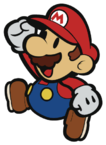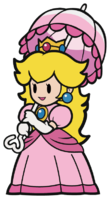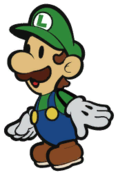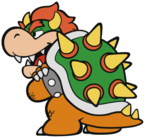Paper Mario (series)
This article is under construction. Therefore, please excuse its informal appearance while it is being worked on. We hope to have it completed as soon as possible.
It has been requested that this article be rewritten. Reason: the character bios are far too long and need considerable trimming (tagged on September 28, 2014)
Template:Articleabout Template:Series-infobox The Paper Mario series is an RPG action-adventure series of the Mario franchise developed by Intelligent Systems. Five games have been released - four for home consoles and one for the Nintendo 3DS. The series has gone through three iterations so far: Paper Mario and Paper Mario: The Thousand-Year Door are RPGs, Super Paper Mario is a RPG-platformer hybrid, and Paper Mario: Sticker Star and Paper Mario: Color Splash are action-adventure, RPG-styled games.
Chronological overview
Main series
| Title | |
|---|---|
| Cover, original release and system | Synopsis |
| Paper Mario | |
| File:Papermario.PNG Template:Releasedate Nintendo 64 |
The series began in 2000 with Paper Mario. This was the second Mario RPG to be made, the first being Super Mario RPG: Legend of the Seven Stars. This game was originally going to be called Super Mario RPG 2, but the name was changed due to copyright issues with Square Enix. The game starts off with Mario receiving an invitation to Princess Peach's Castle, but when he arrives, the castle is lifted up into the sky. This was caused by Bowser, who has stolen the legendary Star Rod, which can grant people's wishes. After being defeated, Mario must rescue the seven Star Spirits to be able to return to Bowser's Castle, recover the Star Rod and save Peach. The game was released on the Wii's Virtual Console in 2007 and the Wii U's in 2015. |
| Paper Mario: The Thousand-Year Door | |
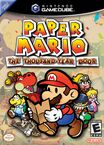 Template:Releasedate Nintendo GameCube |
Later, in 2004 Paper Mario: The Thousand-Year Door was released. Known as Paper Mario RPG in the Japanese territory, this game introduces the Paper Mario moniker in Japan. The antagonist is Sir Grodus, the leader of the X-Nauts. The X-Nauts have kidnapped Peach, and Mario heads to the seaside town of Rogueport to rescue her by finding the Crystal Stars. The game is a role-playing game like its successor, and shares many of its gameplay mechanics. Bowser makes his first playable appearance during platforming sequences. |
| Super Paper Mario | |
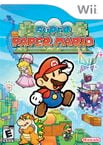 Template:Releasedate Wii |
The third installment in the series, Super Paper Mario, removes the turn-based system and becomes a platformer-RPG hybrid. Mario and Luigi go to Bowser's Castle to rescue Princess Peach, but learn Count Bleck is behind her disappearance, and soon Luigi, Bowser and the entire Koopa Troop get captured as well. Mario must travel to the town of Flipside with Tippi to recover the eight Pure Hearts and prevent the world's destruction. Alongside the new platforming format, a new mechanic is introduced: Mario can Flip between 2D and 3D, changing the perspective of the environment at any time. The game was released on the Wii U's Virtual Console in 2016. |
| Paper Mario: Sticker Star | |
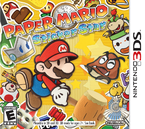 Template:Releasedate Nintendo 3DS |
The fourth installment of the series was released for the Nintendo 3DS in 2012, making it the first handheld installment of the series. Unlike the previous title, the perspective is 3D again, but the game stops being a RPG and focuses on puzzle-solving and using stickers to attack. When Bowser accidentally destroys the Sticker Comet, Mario goes on an adventure with Kersti to recover the six scattered Royal Stickers, restore the Sticker Fest and rescue Princess Peach. Not being a RPG, this game removes elements of previous Paper Mario titles such as partners and Experience Points. |
| Paper Mario: Color Splash | |
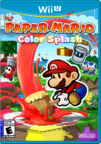 Template:Releasedate Wii U |
The fifth installment of the series was released for the Wii U in 2016. The game involves Mario using the Paint Hammer in order to color in colorless characters and level elements and progress through the story. This coloring feature is also implemented into battles, which appear to be quite similar in gameplay to Paper Mario: Sticker Star. |
Crossover
| Title | |
|---|---|
| Cover, original release and system | Synopsis |
| Mario & Luigi: Paper Jam | |
 Template:Releasedate Nintendo 3DS |
The fifth release of the Mario & Luigi series crosses over with the Paper Mario series, and was originally released in late 2015. One day, Luigi stumbles upon a book containing the Paper Mario universe, and accidentally releases the Paper Mario versions of various characters from the book. Despite some arguments, the two Bowsers decide to team up, combine their Koopa Troop armies, and kidnap the two Peaches. Thus, the Mario Bros. team up with Paper Mario to rescue both versions of Princess Peach from Bowser and Paper Bowser. |
Gameplay
Exploration
Having its roots in the action-RPG genre that Super Mario RPG: Legend of the Seven Stars followed, Mario is the primary character to be controlled in the Paper Mario series and finds himself in 3D settings in which items can be found, foes can be fought, and non-playable characters can be discussed with. However, unlike Super Mario RPG: Legend of the Seven Stars's isometric view, areas in the Paper Mario series are reminiscent of levels in the main Mario series such as Super Mario World by generally being made of simple horizontal paths, with Mario having to go from the left to the right and finding enemies and secrets along the way, while going through platforming trials, collecting coins and striking Blocks. To discover secrets, Mario can use many abilities he gains over the course of the game, such as a Hammer to strike Blocks, a Koopa Troopa shell to reach distant objects or the ability to remove and replace elements of the environment. Traps can also be found in the field however, and will decrease Mario's HP if he gets harmed, although his HP cannot drop below 1, except in Paper Mario: The Thousand Year Door and Super Paper Mario. Save Blocks and Heart Blocks can be found, saving the player's game and healing Mario's HP and FP respectively.
Towns can also be visited, and act as areas in which Mario can rest, craft new items, talk to residents and shop for items. Side quests can also be found in towns, generally consisting in helping out dwellers in exchange for rewards. Each game has a main town as well that acts as a bigger area where the player may need to return to frequently for purposes revolving around the story, such as unlocking the next area that needs to be visited. These towns gradually change as the story advances, and in the case of the first three games of the story, also possess underground areas and optional battles. These towns are Toad Town for Paper Mario, Rogueport for Paper Mario: The Thousand-Year Door, Flipside for Super Paper Mario, Decalburg for Paper Mario: Sticker Star and Port Prisma for Paper Mario: Color Splash.
Certain side quests will lead to an optional partner being obtained. Hidden objects such as Badges, Star Pieces, Coins and Stickers can also be found. Such items can make Mario stronger, making the game easier to progress through. In Paper Mario: Sticker Star exclusively, HP-Up Hearts may also be found, giving Mario more HP and First Strike Attack Power.
Battling
Battles are an essential aspect of the Paper Mario series. While exploring, Mario will encounter enemies on the field, who will generally attempt to engage him into battle upon seeing him. Although battles are important, the way they work is regularly changed in the series, with the only consistent element being HP (Heart Points), which indicate Mario's health and decrease depending on how much damage he receives: if his HP reach zero, the player obtains a Game Over and must resume the game from their latest save point.
Paper Mario and Paper Mario: The Thousand-Year Door
Several characteristics are found in battle and help Mario defeat his foes:
- HP: Heart Points. They decrease when Mario gets hit by an enemy or gets poisoned, and increase when he uses a recovery item such as a Mushroom or recovers automatically with a Happy Heart badge. Enemies also share this characteristic, and their amount of HP can be seen if they are Tattled with Goombario in Paper Mario and Goombella in Paper Mario: The Thousand-Year Door or with the Peekaboo badge. If Mario's HP hit zero, the player gets a Game Over, but if an enemy's HP hit zero, they are defeated. Mario begins at 10 HP and can reach up to 50 HP (200 HP in Paper Mario: The Thousand-Year Door) without badges or Chet Rippo.
- Attack Power: Mario shares this trait with partners and enemies. Attack Power determines how many HP are lost by the opponent upon being attacked after being subtracted by the opponent's Defense Power, however partners do not have HP and instead remain knocked out for as many turns as the Attack Power of the attack that hit them, subtracted by their Defense Power. Attack Power is leveled up for Mario when obtaining stronger versions of his Boots and Hammer, while it is leveled up for partners with Super Blocks (Shine Sprites brought to Merlon in Paper Mario: The Thousand-Year Door). Without badges, Mario's Attack Power begins at 1, his Super Boots and Super Hammer Attack Power is 2, and his Ultra Boots and Ultra Hammer Attack Power is 3.
- Defense Power: Mario shares this trait with partners and enemies. While Attack Power makes an attack stronger, Defense Power makes it weaker, as seen above. The actual strength of an attack follows this equation: Attack Power - Defense Power = actual strength of an attack. Mario and his partners' Defense Power remains at 0 without badges, or at 1 for Kooper, Parakarry and Koops. Watt and Ms. Mowz's attacks also ignore Defense Power.
- FP: Flower Points. Different moves will require a different amount of Flower Points, and if Mario does not have enough, him and his partner will be unable to use attacks that need them. They increase when Mario uses a recovery item such as a Honey Syrup. Mario begins at 5 FP and can reach up to 50 FP (200 FP in Paper Mario: The Thousand-Year Door) without badges or Chet Rippo.
- BP: Badge Points. Although they do not directly appear in battle, they are necessary to equip Badges and as such use stronger attacks and strategies. They can be used on the pause screen outside of battle: equipping a Badge will reserve a certain amount of BP for that Badge, and unequipping it will restore the same amount of BP. Badges can give Mario new attacks such as Power Jump, allow new commands such as Group Focus, enhance his abilities in the field such as Speedy Spin, etc. Mario begins at 3 BP and can reach up to 30 BP (99 BP in Paper Mario: The Thousand-Year Door) without Chet Rippo.
- Star Power: Star Power is a gauge made up of seven units (eight units in Paper Mario: The Thousand-Year Door) that is used for Special Moves. Mario will gain 1 Star Power unit with every Star Spirit he rescues. When the gauge depletes in Paper Mario, one fraction of a unit will be automatically filled up after each turn, although Mario can use Focus to manually fill up the gauge.
- Audience: When the gauge depletes in Paper Mario: The Thousand-Year Door, the audience will fill up Mario's Star Power gauge to a varying amount, depending on the number of active people in the audience, on Action Commands being performed correctly, and on Stylish Moves being executed. The audience may also give Mario free Items, damage him or his partners, or cause havok on the stage. The audience's maximum capacity is 50 when Mario is level 1, and reaches up to 200 when Mario is level 30.
- Partners: In battle, Mario is helped out by a partner character that was met in the story. Partners have their turn after Mario's and can use the Abilities and Strategies commands just like him, as well as the Items command in Paper Mario: The Thousand-Year Door. In Paper Mario, they do not have their own HP or FP: they will be knocked out of battle for the same amount of turns as the strength of the attack that hurt them, and their FP reserves are shared with Mario, however they have their own Attack Power and Defense Power, the former being upgraded with Super Blocks. They also cannot suffer Status effects. In Paper Mario: The Thousand-Year Door, partners have their own HP and can suffer from Status effect, and cannot be used for the rest of the battle unless they are revived with a Life Shroom. Partners are acquired throughout the story, and Mario can choose from eight partners by the end of the game, with one partner being optional in Paper Mario: The Thousand-Year Door.
- Star Points: When enemies are defeated, they drop Star Points. Once Mario collects 100 Star Points, he levels up and resets to 0 Star Points. Mario cannot obtain more than 100 Star Points in a battle, and after leveling up enough, earlier enemies will stop giving out Star Points. When leveling up, the player can upgrade Mario's HP by 5, his FP by 5, or his BP by 3. Mario starts out at level 1 and can get up to level 27 (level 99 in Paper Mario: The Thousand-Year Door). Each partner also has his/her own technique outside of battle.
- Bingo!: This feature only exists in Paper Mario: The Thousand-Year Door. Two symbols are on the screen: each is randomly chosen after a successful Action Command, and both are reset if they are both chosen but do not match. If they do match, the Bingo! game appears, and the player has to line up a symbol on a slot game to the two others, with different effects taking place if the game is won:
- Mushroom: Mario and his partner's HP are fully restored.
- Flower: Mario's FP are fully restored.
- Star: Mario's Star Power is fully restored.
- Shine Sprite: Mario and his partner's HP, FP and Star Power are fully restored.
- Poison Mushroom: Mario and his partner's HP, FP and Star Power are cut in half.
- If the Bingo! game is won in all cases but the Poison Mushroom, the audience is also filled up to its highest capacity. In the case of the Poison Mushroom, the audience becomes empty.
Super Paper Mario
Super Paper Mario replaces its predecessors' turn-based battle system for real-time battles instead.
- HP: HP, Attack Power and Defense Power return and work the same way as they did in the previous titles, however it is impossible to tell how many HP enemies have left, although they can still be Tattled with Tippi. The party begins at 10 HP and can reach up to 999 HP. Mario, Luigi and Peach have the same Attack Power while Bowser has double their Attack Power, and all the characters have a Defense Power of 0 without Items. The party's Attack Power begins at 1 and can reach up to 99 (198 for Bowser).
- Items: Special Moves do not appear but certain Items can be used for powerful attacks instead, and use Action Commands.
- Pixls: As there is no separation between the action field and battles anymore, the player character can use the abilities of Pixls to attack as well as interact with the environment, but Pixls do not act like Partners and as such do not attack on their own.
- Points: Points now replace Star Points, upgrading either the characters' HP or Attack Power upon leveling up. Points can be obtained by hitting enemies, defeating them or hitting several of them in a row, collecting Coins, and doing Stylish Moves. The party begins at level 1 and can reach up to level 99, with 99,999,999 Points.
Paper Mario: Sticker Star
Paper Mario: Sticker Star returns to turn-based battles, but uses a different battle system from the first and second installments.
- HP: HP returns with the same function as in the previous titles, however it is now impossible to tell how many HP individual enemies have, as the Tattle ability is gone. Because leveling up is gone, Mario can only increase his HP by finding HP-Up Hearts in the field, and collecting one will permanently upgrade Mario's HP by 5. Mario begins at 20 HP and can reach up to 100 HP with all HP-UP Hearts collected.
- Attack Power: Attack Power and Defense Power work similarly to how they did in previous titles. Because Mario does not level up, his strength remains the same for the course of the game but there exist six different degrees of Attack Power for attack-based Stickers: Attack Power of 3 for Worn-Out Stickers, 7 for regular Stickers, 13 for Shiny Stickers, 21 for Flashy Sticker, 28 for Big Shiny Stickers and 38 for Megaflash Stickers. It is also possible to upgrade Mario's First Strike Attack Power with HP-Up Hearts: two HP-Up Hearts will increase it by one point. Mario's First Strike Attack Power begins at 3 and can reach up to 11 with all HP-Up Hearts.
- Defense Power: Unlike in previous installments, two types of Defense Powers can be found: subtractive Defense Power and divisive Defense Power. Subtractive Defense Power works much like the way it did in previous titles: the actual strength of an attack is the result of the attacker's Attack Power subtracted by the opponent's Defense Power. Divisive Defense Power works differently: the actual strength of an attack is the result of the attacker's Attack Power divided by the opponent's Defense Power.
- Stickers: Stickers are the main mechanics used in Paper Mario: Sticker Star. In battle, Stickers are used as consumable moves that may be offensive (Jump, Hammer), healing (Mushroom) or defensive (Frog Suit). They vanish after a single use, but can be bought in shops and found in the field. Although they work as a counterpart to the battle mechanics of Paper Mario and Paper Mario: The Thousand-Year Door, they all use Action Commands and it is possible to run out of Stickers. Stickers may be randomly given to Mario if he starts to run out of resources, and it is possible to run away from most boss battles to restock oneself on Stickers.
- Things: Things are 3D objects that Mario can find outside of battle. By using the Sling-a-Thing in Decalburg or the Outlook Point, Mario can turn Things into Stickers and use them in battle. Thing Stickers work as Special Moves, being particularly powerful attacks, and much like Special Moves in Paper Mario: The Thousand-Year Door and Items in Super Paper Mario, Action Commands must be used to make the attacks more effective. In addition, most bosses are weak to certain Thing Stickers.
- Album: The Album contains Mario's inventory. It contains a limited amount of pages, and Stickers will take a different amount of space on the Album's pages as well. Mario starts out with 2 Album pages which can contain up to 30 regular Stickers, and reaches up to 8 Album pages, which can contain up to 120 regular Stickers.
- Battle Spinner: Kersti lets Mario use the Battle Spinner, which originally costs 3 Coins to use but increases in price if Mario keeps using it in battle. A slot game appears and the player must align the same symbol two or three times. If two same symbols are aligned, Mario can use two attacks for one turn. If three symbols are aligned, Mario can use three attacks for one turn and two attacks for the next turn, and one of the following effects happens depending on the aligned symbols:
- Coin: Mario receives Coins.
- Mushroom: Mario recovers 20 HP.
- Fire Flower: Hurts all enemies for 3 damages, except for airborne or fire-resistant enemies.
- POW Block: Hurts all enemies for 3 damages, except for airborne enemies. May give them the Crumpled status effect as well.
- Thunder Bolt: Hurts all enemies for 3 damages. May cause them the Dizzy status effect as well.
- Poison Mushroom: Gives Mario the Poison status effect for 9 turns. Enemies who touch Mario also get poisoned.
Main characters
| Character | ||
|---|---|---|
| Image | Brief Biography | |
| Mario | ||
| Mario is the main hero of the series. He is often saving Princess Peach from Bowser using his trademark Jump and Hammer, but also saves her from other villains in the series, such as Grodus and Count Bleck.
In Paper Mario, he recovers the seven Star Spirits to get the Star Rod back from Bowser after the villain steals it from Star Haven and lifts Peach's Castle in the sky alongside his own. After meeting many partners along the way, he successfully rescues the Star Spirits and Princess Peach, retrieves the Star Rod and defeats Bowser and his army. In Paper Mario: The Thousand-Year Door, Mario receives a letter from Peach, saying she's found a treasure map at Rogueport. He then learns she has been kidnapped by the evil group of the X-Nauts, who are after the seven Crystal Stars as well. Using the magic of the Magical Map, Mario goes to find the Crystal Stars and Princess Peach, and meets new partners along his adventure. Mario obtains new powers and can turn into a paper plane, paper roll and paper boat. After many difficult battles, he destroys the Shadow Queen's soul in the Shadow Palace and saves Peach again. In Super Paper Mario, Mario finds himself thrown in an interdimensional adventure, in which, with the help of Tippi, he must find the eight Pure Hearts to prevent Count Bleck from using the Chaos Heart to destroy all worlds. After being reunited with Peach, Bowser and Luigi and facing Count Bleck's minions, Mario successfully defeats Dimentio and foils the Dark Prognosticus' prophecies. In Paper Mario: Sticker Star, Mario must recover the six Royal Stickers to restore the wish-granting Sticker Comet after Bowser destroys it and kidnaps Princess Peach. With the help of Kersti, he retrieves the Comet Pieces and Royal Stickers and defeats Bowser again. In Paper Mario: Color Splash, Mario must recover the six Big Paint Stars to restore the Prisma Fountain's paint, repaint the entirety of Prism Island, hunt down the members of the Rescue Squad V, and defeat Bowser and the Koopalings, all with the help of Huey, a living paint can. | ||
| Princess Peach | ||
| Princess Peach is the damsel-in-distress of the series. She is the ruler of the Mushroom Kingdom and lives in her castle. Though captured throughout the games, Peach still is not completely helpless, and does whatever she can to lend Mario her help.
In Paper Mario, Princess Peach holds a party at her castle but Bowser disturbs it by lifting her castle into the sky with his own, defeats Mario, and captures Peach and many of her guests. Peach remains sealed inside her own castle for the majority of the game, but with the help of Twink recovers information for Mario by sneaking past Bowser's guards. However, she becomes unable to help Mario after she gets taken to the top of the castle in preparation for Mario's arrival and battle with Bowser. During Mario and Bowser's confrontation, Peach wishes to the Star Spirits for Mario to get stronger, creating the Peach Beam and allowing for Bowser to lose his invincibility. She is eventually rescued by Mario and her castle is brought back to its righteous location. In Paper Mario: The Thousand-Year Door, while on a stop to Rogueport, Peach sneaks away from Toadsworth and finds a Magical Map being given to her by Beldam. She sends Mario the map by mail, but gets kidnapped by the the X-Nauts afterward and ends up being kept in their secret base on the Moon. Thanks to TEC-XX, she is allowed to communicate with Mario and obtain information on Grodus' plans, but in compensation she must teach TEC what love is. Later on, she gets taken away from the Moon and into the Shadow Palace, as she was being kept for the purpose of using her body to revive the Shadow Queen. After Mario defeats her in her possessed form, she returns to normal and leaves Rogueport with him, but eventually brings him on another treasure-hunting adventure after finding another map. In Super Paper Mario, Princess Peach gets kidnapped by Count Bleck and forcefully married to Bowser so that the Chaos Heart may be created and destroy all worlds through the Void. She later manages to run away from Bleck Castle and joins Mario on his adventure to find the eight Pure Hearts and counter the Dark Prognosticus. After being reunited with Bowser and Luigi and fighting Count Bleck's minions (specifically Mimi), she defeats Dimentio and puts an end to the Chaos Heart. In Paper Mario: Sticker Star, Peach hosts the Sticker Fest but gets kidnapped by Bowser after a Royal Sticker falls on his head following the destruction of the Sticker Comet. She remains in Bowser's Sky Castle, waiting for Mario to rescue her. After Mario solves this incident, she hosts the renewed Sticker Fest. In Paper Mario: Color Splash, Peach brings Mario a letter she received from Prism Island, revealed to be a drained Toad. Peach takes Mario on her ship to Port Prisma where they find it drained of color. While Mario sets off on his adventure with Huey, Peach stays behind at Port Prisma. After Mario collects the Big Red Paint Star, Black Bowser kidnaps Peach, taking her back to his castle. Peach will occasionally send Mario a Holo-Peach message to keep him updated on her situation, until Black Bowser drains her color. After Mario defeats Black Bowser, he restores Peach's color and they escape on Luigi's kart. | ||
| Luigi | ||
| Luigi is Mario's younger, less courageous brother. His role in the Paper Mario series tends to be minor and irrelevant to the storyline, with the exception of Super Paper Mario.
In Paper Mario, Luigi goes to a party hosted by Princess Peach at her castle, but escapes when Bowser starts lifting the building into the sky. He spends the remaining of the game at Mario's House, waiting for his brother to rescue Peach and writing his secret diary. After the castle is brought back to the ground, Peach hosts another party and Luigi leads the following festival. In Paper Mario: The Thousand-Year Door, Luigi goes on his own adventure that is documented in the Super Luigi series. After Mario leaves on an adventure to Rogueport, another letter is received at Mario's house, from Minister Crepe of the Waffle Kingdom. Luigi travels to the Waffle Kingdom to rescue Princess Eclair from the Chestnut King, and meets many partners along the way to recovering the seven parts of the Marvelous Compass in hope to locate Eclair. As his travels bring him to many continents, he stops regularly at Rogueport and as such meets Mario and tells him his story. Ultimately, Luigi defeats either the Chestnut King or Minister Crepe depending on who tells the story, and brings peace back to the Waffle Kingdom. In Super Paper Mario, Luigi gets kidnapped by Count Bleck as the Dark Prognosticus calls him the perfect host for the Chaos Heart. Luigi gets brainwashed into Mr. L and acts as an antagonist to Mario, Peach and Bowser and attacks them with his Brobot. However, Dimentio sends him to the Underwhere, undoing his brainwashing and allowing him to join back Mario's party. It is revealed that Dimentio planted a seed in Luigi's mind along the way, turning him back into Mr. L for the final confrontation and merginng with him and the Chaos Heart to become Super Dimentio. Mario's party defeats Super Dimention, giving Luigi back his mind and appearance, and ultimately saving the world from being destroyed by the Chaos Heart. In Paper Mario: Sticker Star, Luigi is found in five locations, aimlessly adventuring around the Mushroom Kingdom. Mario can make him leave using Paperization, which will lead to a newspaper entry being written about Luigi's whereabouts. In Paper Mario: Color Splash, Luigi is found in six locations across Prism Island, and Mario can find him using the Cutout Technique, leading to Luigi giving Mario coins before running off-screen. Mario will receive mail from his brother each time he is found, telling him about various game mechanics. After collecting all the Big Paint Stars, Luigi will drive into Port Prisma on his kart to give Mario and Huey a lift up to Black Bowser's Castle. | ||
| Bowser | ||
| Bowser is Mario's arch-enemy, with ambitions of world domination with Peach at his side. As the leader of the Koopa Troop, he is a recurrent and formidable threat to the Mushroom Kingdom, but does not wish for its destruction.
In Paper Mario, Bowser and Kammy Koopa steal the Star Rod, a magical device that grants wishes, and imprison the seven Star Spirits who are supposed to protect it. Bowser also uses his castle to hijack Princess Peach's Castle, with Peach still inside, and lifts the castle high into the sky. He wishes to become invincible and to beat Mario, but is eventually defeated thanks to the power of the Star Spirits and his castle explodes. In Paper Mario: The Thousand-Year Door, Bowser learns that Peach has been kidnapped and that Mario is after Crystal Stars and leaves for Rogueport to rescue Peach and beat Mario to the punch at getting the Crystal Stars. With Kammy Koopa, Bowser travels through the lands surrounding Rogueport, but always falling behind Mario and the X-Nauts' progression, before accidentally finding his way to the Palace of Shadows and fighting Mario. In Super Paper Mario, Bowser gets kidnapped by Count Bleck and married to Princess Peach to give birth to the Chaos Heart, which would destroy all worlds as the Dark Prognosticus foretells. Although he is pleased with the matter of becoming Peach's husband, disturbances during the marriage cause him to be sent to The Bitlands while most of his army remains in Bleck Castle and gets brainwashed into servitude. Although opposing Mario is usually Bowser's priority, not letting all worlds get destroyed is more important for him, or else he would have no territory to rule over in the first place, and this leads to him joining Mario and Peach in their adventure to recover the eight Pure Hearts. After facing many obstacles and fighting against his own troops as well as Count Bleck's commanders (notably O'Chunks), Bowser defeats Dimentio and prevents the world-ending prophecy from taking place. In Paper Mario: Sticker Star, on the night of the annual Sticker Fest, Bowser shows up and touches the Sticker Comet, causing it to explode and the Royal Stickers to get scattered over the Mushroom Kingdom. One of the Royal Stickers lands on Bowser, granting him strength but also turning him insane and out of control. Bowser wrecks havoc on Decalburg and sends his troops to cause incidents throughout the Mushroom Kingdom after kidnapping Princess Peach. Although Kamek and Bowser Jr. are Mario's main opponents throughout his adventure, he eventually discovers the location of Bowser's Sky Castle, defeats him, takes back the final Royal Sticker and rescues Peach. Bowser shows up again during the second attempt at celebrating the Sticker Fest and tries to touch the Sticker Comet again, but gets scolded by Kersti. In Paper Mario: Color Splash, Bowser jumps into Prisma Fountain in Port Prisma, wanting to turn his shell rainbow colored. He accidentally mixes the colors of the fountain, turning it into black paint, which then brainwashes Bowser, turning him into Black Bowser. Black Bowser orders his minions to drain all the color from Prism Island and its inhabitants, using it to make more black paint to cover the world. When Mario fights Black Bowser, he is briefly freed form the black paint's control before reverting back to Black Bowser, growing giant. Mario and Huey eventually save Bowser from every drop of black paint, finishing him off before his castle begins to fall. | ||
Similarities between the games
- In all four console entries, the story opens up with a letter at Mario's House.
- In all the games, Mario has to fight one or more of his allies at least once. In Paper Mario he fights Lakilester, in Paper Mario: The Thousand-Year Door he fights Vivian along with her sisters and also fights the tricked Goombella, Koops, Flurrie and Yoshi with Doopliss, in Super Paper Mario he fights Bowser and Mr. L (Luigi) twice each, in Paper Mario: Sticker Star, each Wiggler Segment is fought, and in Paper Mario: Color Splash, he fights Black Bowser and a group of angry toads.
- In the first three console games, Mario is able to temporarily transform into an 8-bit version of himself: after falling into a vase in Boo's Mansion in the first game, after landing behind a curtain in X-Naut Fortress in the second game, and whenever he obtains a Mega Star in the third game.
- Each console game has narration with Mario falling asleep. When he wakes up, the storyteller asks if he's been listening, followed by Mario lying by nodding. In Paper Mario, Madam Merlar tells the story. In Paper Mario: The Thousand-Year Door, Luigi and the shopkeeper in Twilight Town tell the stories. In Super Paper Mario, Merlumina tells the story.
- All five games involve one or more giant Bloopers as a boss.
- In Color Splash, the giant blooper is a target to fire cannonballs at.
- All five games involve a grassland setting followed by a fortress of some sorts during the first chapter or world in the game.
- The first four games involve a primitive setting in the fifth chapter or world: a distant island with a jungle in the first two games and in the fourth game, and a prehistoric world in the third game.
- All five games have at least one game show event. In Paper Mario there is the 64th Trivia Quiz-Off, in Paper Mario: The Thousand-Year Door there are the two Super Fun Quirk Quizes, in Super Paper Mario there is "That's My Merlee!" Show, and in Paper Mario: Sticker Star and Paper Mario: Color Splash, there is Snifit or Whiffit.
- In all five games, the final boss is a powerful version of a member of the team of Super Paper Mario: in the first game it is an invincible Bowser using the Star Rod, in the second game it is Princess Peach possessed by the Shadow Queen, in the third game it is Super Dimentio who is a mixture of Dimentio, the Chaos Heart and Mr. L, in the fourth game it is a giant Bowser turned insane by a Royal Sticker, and in the fifth game is Bowser infused with black paint.
- All five games had a remix of the Super Star theme play somewhere. In Paper Mario, when Mario runs around a certain Candy Cane in Pleasant Path, the theme will start playing. In Paper Mario: The Thousand-Year Door, when playing the Bowser segments, if the player collects enough Meat in a level, Bowser grows huge and the theme plays. In Super Paper Mario, when the player obtains a Mega Star, the theme plays, and in Paper Mario: Sticker Star and Paper Mario: Color Splash, the theme plays when the player grabs a Star.
Trivia
- The Paper Mario title itself is mentioned in several games. In the party at the end of Paper Mario, a Bumpty mentions that Herringway is writing a novel called "Paper Mario". The same occurs in Paper Mario: The Thousand-Year Door with the blue Toad living in a house in the Rogueport west side, who also writes a Paper Mario novel based off Mario's adventures, which gets adapted into a play.
- The novel written by Herringway is titled "Mario Story" in Japanese. In Luigi's Mansion, Neville can be seen reading a book with the same title.
